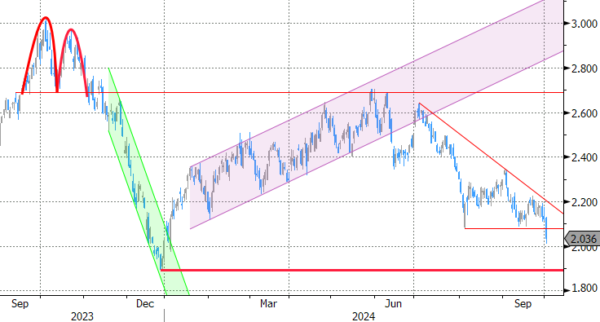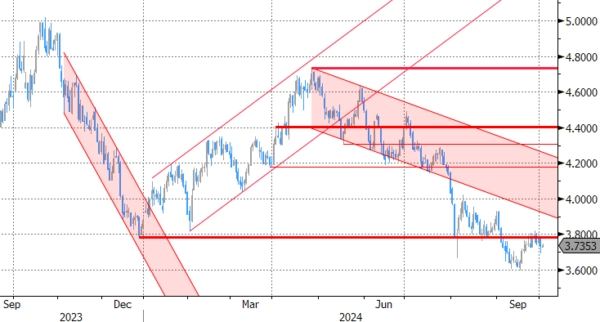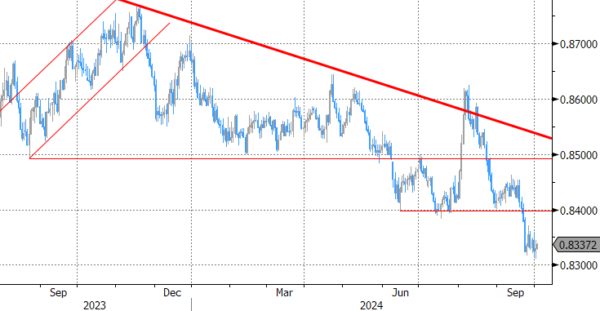Markets
German Bunds outperformed US Treasuries yesterday. German yields closed 4.8 bps (2-yr) to 9.8 bps (30-yr) lower. The curve move was at least partly inspired by technical reasons (acceleration after losing support from August & September lows at long tenors) and by intraday deteriorating risk sentiment (around the start of US trading) as tensions in the Middle East culminated in an Iranian missile attack against Israel. European (-1%) and US stock markets (-0.5% to -1.5%) switched gains for losses. The resulting increase in oil prices (Brent from $71/b to $75/b) didn’t offer any counterweight at the long end of the curve. Earlier in European trading, ECB easing bets were unaltered by September EMU inflation which showed core CPI (2.7% Y/Y) and services CPI (4% Y/Y) remaining sticky. US yields ended 3.6 bps to 5.1 bps lower with the belly of the curve outperforming the wings. Eco data were mixed with JOLTS job openings unexpectedly increasing from 7.67mn to 8.04mn, but details of the manufacturing ISM (steady at 47.2; mired in contraction territory) painting a bleak picture. Markets especially paid attention to the latter with the pace of job shedding increasing again (43.9 from 46; 2nd worse since mid-2020), new orders still under pressure (46.1 from 44.6) and prices paid falling (48.3 from 54) for the first time this year. The figures brought the odds for the November Fed meeting again more in balance: 60/40 in favour of a 25 bps rate cut over a 50 bps move. Today’s US ADP employment report and a speech by Richmond Fed Barkin will undoubtedly create some more volatility. We fear that this week’s data, nor mid-October CPI numbers or early November US eco data will eventually completely settle the debate. We continue to err on the side of another 50 bps rate cut. Other things to watch out for today are a flurry of ECB speakers and obviously risk sentiment as Israel plans a significant retaliation to the Iran attack within days. Safe haven currencies like JPY and CHF already show some outperformance this morning with the dollar also trying to build on yesterday’s gains. The trade-weighted greenback left this year’s lows just above 100 behind this week, extending the comeback to 101.30. First resistance stands around 102. EUR/USD mirrored the move, ending the test of 1.12 resistance to currently changed hands at 1.1060. First support stands at 1.1002.
News & Views
Martin Schlegel told Bloomberg yesterday that the Swiss National Bank stands ready to intervene in currency markets if needed but added that the policy rate remains the central bank’s main instrument. The fresh SNB president said in the wake of last Thursday’s 25 bps rate cut to 1% that more reductions are likely. Swiss inflation eased to just 1.1% in August and risks are tilted to the downside. For Swiss (export) companies the currency is increasingly weighing on business. But given the limited easing room from the current policy rate levels, there’s only so much the central bank can do before turning to actual FX interventions … unless it brings rates back into sub-zero territory. Schlegel in the interview said it couldn’t be excluded. The SNB pushed the policy rate as deep as -0.75% before kicking of a tightening cycle in response to the post-pandemic inflation upswing. The Swiss franc was not at all impressed by the potential return of negative rates though. EUR/CHF ended the day lower (0.936) as geopolitical developments spurred safe haven flows.
Rating agency Moody’s raised Brazil’s sovereign rating to Ba1 from Ba2 yesterday and maintained a positive outlook. That’s just one notch below investment grade, a status it lost almost a decade ago. The upgrade reflects material credit improvements which Moody’s expect to continue, amongst others due to a more robust growth performance (now seen at 2.5% for 2024 and over the medium term) than previously expected. Moody’s hailed the growing track record of economic reforms, although the credibility of the country’s fiscal framework is still only moderate, as reflected by the relatively high cost of debt. But steady growth and compliance with the fiscal framework should help enhance institutional credibility and reduce borrowing costs markedly and more than Moody’s earlier assumed. This lead the agency to retain Brazil’s positive outlook. Fitch and S&P Global, the two other major rating agencies, upgraded Brazil to BB last year, two notches below investment grade. The Brazilian real erased earlier losses in the wake of Moody’s decision yesterday. USD/BRL closed around 5.44.
Graphs
GE 10y yield
The ECB cut policy rates by 25 bps in June and in September. Stubborn inflation (core, services) makes a follow-up move less evident in October, but very weak PMI’s and soft Lagarde comments hang in the balance. Disappointing US and unconvincing-to-outright-weak EMU activity data dragged the long end of the curve down with the 2023 low at 1.89% as key support.
US 10y yield
The Fed kicked off its easing cycle with a 50 bps move. It is headed towards a neutral stance now that inflation and employment risks are in balance. Conservative SEP unemployment forecasts risk being caught up by reality and with it the dot plot (50 bps more cuts in 2024). We hold our call for two more 50 bps cuts this year. Pressure on the front of the curve and weakening eco data keeps the long end in the defensive for now as well.
EUR/USD
EUR/USD moved above the 1.09 resistance area as the dollar lost interest rate support at stealth pace. US recession risks and bets on fast and large rate cuts trumped traditional safe haven flows into USD. An ailing euro(pean economy) only briefly offset some of the general USD weakness. EUR/USD’s dollar-driven bumped into 1.12 resistance.
EUR/GBP
The BoE delivered a hawkish cut in August. Policy restrictiveness will be further unwound gradually on a pace determined by a broad range of data. The strategy similar to the ECB’s balances out EUR/GBP in a monetary perspective. But the economic picture is increasingly diverging to the benefit of sterling. EUR/GBP succumbed to horrible European September PMI’s. Support at 0.84 broke and brings the 2022 low (0.8203) on the radar.
















